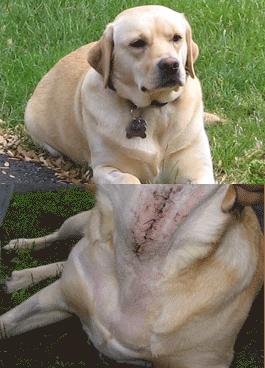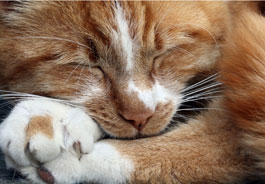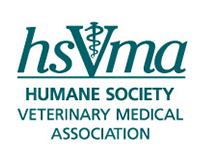The Ethics of ConvenienceBy Eileen Jefferson, DVM December 6, 2011  Stella's devocalization surgery left scar tissue that obstructed 50% of her airway, necessitating a second corrective surgery (bottom photo). Dottie Venetto There is legislation currently pending in New York that would prohibit the devocalization of dogs and cats, except to treat a medical condition causing the animal physical harm. Last year, the Massachusetts governor signed a similar bill into law, effectively banning devocalization in that state. Devocalization, or ventriculocordectomy, is the surgical removal of part or most of an animal’s vocal cords. It is one example of a controversial surgery veterinarians may perform to reduce or eliminate unwanted but natural companion animal behaviors, in this case barking or meowing. Declawing, or onychectomy, is another contested surgery still widely performed in the U.S., although it has been legally banned in more than 25 countries, including most recently Israel, as well as eight U.S cities. Like devocalization, declawing continues to create disagreement and division within the American veterinary profession. Because devocalization and declawing surgeries place patients at risk without imparting physical benefit, they are often referred to as convenience surgeries. Many veterinarians decline to perform convenience surgeries on ethical grounds alone, since these procedures inhibit an animal’s natural behaviors and perpetuate avoidance of responsibilities inherent in living with the animal, at the expense of the animal. In the case of declawing, ethical objections have not served as sufficient grounds for many American veterinary professionals to fully condemn the surgery. Instead, the American veterinary profession has focused on inconclusive technical data and research studies as justification for not completely opposing the procedure. An AVMA Backgrounder report published in 2009 entitled “Welfare Implications of Declawing of Domestic Cats” cited 53 different science-based references on the topic of declawing, published over the course of 45 years. However, like many of the individual references cited, the Backgrounder itself was inconclusive, stating, “There is limited scientific evidence to support or refute these claims about the implications of declawing.” ‘These claims’ referred to opposing assertions as to whether declawing more positively or adversely affected the welfare of domestic cats.
As veterinarians, we know that declawing is an invasive procedure involving at least ten separate amputations of a cat’s distal phalanges. Even tenectomy (an alternate procedure that disables scratching via cutting of associated tendons) has a list of risks and potential complications. It is documented and clinically accepted that cats experience postoperative pain from both procedures. Depending on which surgery is performed, cats may also suffer from lameness, hemorrhage, and infection secondary to abnormal claw regrowth. Also, it remains debated among veterinarians to what extent cats may experience decreased muscle tone, effects of abnormal weight distribution across their toes, and personality changes. Resultant pain and feelings of defenseless may be triggers for inappropriate elimination, propensity towards biting, and other negative behaviors. These challenging problems may in turn result in increased risk of shelter relinquishment. In other words, convenience surgery may not even be all that convenient. In light of these concerns, many veterinarians (an increasing number, in my experience) are reluctant to state that they amputate cats’ toes solely for the benefit of preserving furniture, preserving convention, or for monetary reasons alone. Therefore, as welfare concerns mount, it has become increasingly necessary for veterinarians who perform these surgeries to provide a reason why this and other mutilating, risky procedures are actually of benefit to the patient. In the case of declawing, the only purported benefit offered to date is that the human-cat bond may be improved after the procedure; the rationale is that clients will be less likely to relinquish their cats to shelters, abandon them, and/or inflict cruelty upon them if cats do not engage in behaviors that cause destruction of property. The ever-obvious philosophical question is: does one really foster a healthy human-animal bond while condemning and forcibly altering part of the animal, with no benefit to the animal? And, is it unreasonable to think that if one views an integral part of the animal as disposable that he/she may be more likely to view the whole animal as disposable?
Philosophy aside, the “client might dump the cat” rationalization is weak and unscientific because it is based on one of the least probable declawing scenarios. It is certainly not worthy of being the sole justifying reason that we perform this surgery. Again, the veterinary profession has repeatedly demanded science, and not just ethical “opinion” on this topic; it has performed decades of scientific research in search of an answer. Why then, are we continuing to perform this invasive surgery of still-questionable effects based on the “client might dump the cat” scenario?  Whether or not the procedure is actually performed, when a client requests his cat be declawed, veterinary professionals should educate him about what the procedure actually entails; many think it's just a simple nail clip. One widely stated recommendation within the profession is that the veterinarian and client should together explore all other possibilities for feline behavioral modification and alternatives to declawing before performing the surgery. Sadly, declawing in practice is often performed at the time of spay/neuter when the cat is a mere 6-8 months old, or is performed “preventatively” when the cat is first acquired. Other times, the procedure is elected out of frustration immediately following a destructive incident. When a client requests declawing or other convenience surgeries or, preferably, beginning with the animal’s first appointment with the veterinarian, education is of paramount importance. As with any other medical decision, clients are usually looking for our professional recommendation. Our word choice, guidance and example have perhaps the biggest impact on enhancing the human-animal bond and ensuring that animals are well-adjusted in their homes. Clients are much less likely to pursue declawing when they learn from their cat’s trusted doctor that it (1) actually involves multiple, painful amputations of bone, (2) is highly ethically controversial and illegal in dozens of countries and several U.S. cities, (3) is not recommended by multiple veterinary medical associations across the globe, and (4) may cause transient or permanent negative behavioral effects. Likewise, for devocalization, clients should know that potential complications are numerous. A few possibilities include nerve damage, infection, chronic coughing, and aspiration pneumonia. Aside from such physical problems, devocalized dogs and cats have a decreased ability to communicate intentions to other animals and people and therefore are at a greater risk of misinterpretation and/or harm. In addition, even after the animal has been placed in harm’s way for the sake of devocalization, the surgery is not always effective; scarred vocal tissue regrowth may still allow barking or meowing. It is our role in the veterinarian-client-patient relationship to explain that severing an animal’s vocal cords to prevent vocalization is not a recommended course of action. Our emphasis should be on proper training, socialization and care. In light of the recent success of veterinary convenience surgery bans in the U.S., it is possible, if not likely, that devocalization, declawing, ear cropping, tail docking and other non-therapeutic veterinary surgeries may be legally eliminated in the U.S. before veterinarians voluntarily cease performing them. Although some veterinarians may resent legal intervention and view it as an infringement on professional activities, it is our responsibility to uphold medically and ethically sound practices. If a majority of voters morally disagree with certain practices, professional organizations dissuade these practices, and whole countries have deemed them acts of animal cruelty, we should consider that perhaps these procedures are not medically or ethically sound.  Dr. Jefferson with her dogs, Huck and Cosie. Our goal in all cases should be to embrace those changes--whether personal, clinical or legislative--that will make ethically and medically unsound practices least likely to occur. In doing so, we will improve the overall health and well-being of our patients. Eileen Jefferson, DVM graduated with honors from the University of Illinois College of Veterinary Medicine in 2008. She is a former associate editor for the Student American Veterinary Medical Association journal, a lifelong animal shelter volunteer and current member of the Humane Society Veterinary Medical Association.
References:
|
